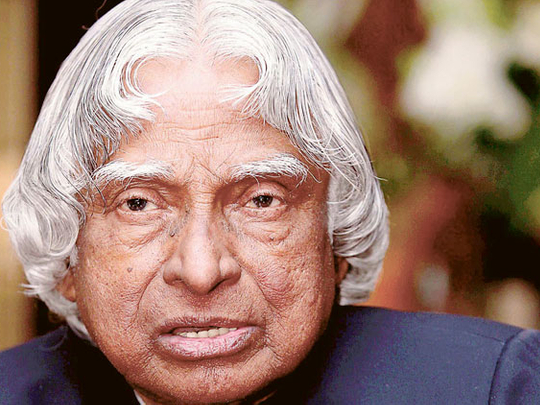
New Delhi Former Indian president A.P.J. Abdul Kalam has emerged as the front-runner to replace outgoing President Pratibha Patil when she retires in July.
Abdul Kalam served as the 11th President of India between 2002 and 2007.
His candidature was proposed by Samajwadi Party chief Mulayam Singh Yadav during his recent meeting with West Bengal Chief Minister Mamata Banerjee.
Tamil Nadu Chief Minister J. Jayalalithaa is also supporting Abdul Kalam, while India's opposition Bharatiya Janata Party (BJP) is also favourably inclined to support the nomination.
Abdul Kalam's name was first proposed by Yadav in 2002 which was readily accepted by the BJP-led National Democratic Alliance government since it also lacked majority in the Electoral College at that time.
Presidential elections get underway next month and May 24 is the last date to file nominations. The ruling Congress party is not in a position to get any presidential nominee elected even with the support of its allies due to lack of numbers.
Consensus
The demand for a non-partisan president was revived yesterday when Federal Agriculture Minister Sharad Pawar, who also heads the Nationalist Congress Party (NCP) said that the new president should be apolitical and be elected with consensus.
"All I have said that after seeing UPA and NDA numbers, all political parties need to sit together and an agreed candidate should be chosen and a dialogue process should be initiated. I never said non-political, I said agreed candidates. It was reported as apolitical," Pawar said.
The Congress party had a tension-filled time in 2007 before finalising Pratibha Patil's candidature who became the first woman president of India after the Left Front which was supporting it from outside rejected several names.
This year, the party was ready with a list of candidates from within, but it would have difficulty in getting anyone of its choice elected due to lack of majority in the electoral college which comprise all elected parliamentarians and state lawmakers.
The Congress party was mulling various names including Finance Minister Pranab Mukherjee, Power Minister Sushil Kumar Shinde, Punjab Governor Shivraj Patil, Lok Sabha Speaker Meira Kumar and incumbent Vice-President Hamid Ansari.
Best choice
While Mukherjee was seen as the best choice and capable of getting support from even outside the ruling United Progressive Alliance, the Congress party was unwilling to let go of Mukherjee, who is the top troubleshooter for both the party and the government.
Patil and Shinde's name did not get approval realising that other parties may not like the idea of having a second successive president from Maharashtra, leaving the choice between Vice-President Ansari and Speaker Kumar. Abdul Kalam had made it clear in 2007 that he would run for the presidential election only if he was made the unanimous candidate.
The Congress party, however, wanted one of its own members to occupy the post. If elected, he will create a record of sorts.
Except for Dr Rajendra Prasad, the first President of India, none of his successors got a second term in office.
Election process
- An electoral college of all elected MPs and MLAs of all state legislatures elect the President.
- India has 776 MPs and 4,120 MLAs. Each MP vote has a value of 708, an MLA's vote value differs from state to state.
- The total value of votes of all 4,120 MLAs is 549,474. The total value of votes of all 776 MPs is 549,408.












